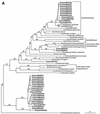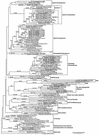Molecular characterization of sulfate-reducing bacteria in the Guaymas Basin
- PMID: 12732547
- PMCID: PMC154542
- DOI: 10.1128/AEM.69.5.2765-2772.2003
Molecular characterization of sulfate-reducing bacteria in the Guaymas Basin
Abstract
The Guaymas Basin (Gulf of California) is a hydrothermal vent site where thermal alteration of deposited planktonic and terrestrial organic matter forms petroliferous material which supports diverse sulfate-reducing bacteria. We explored the phylogenetic and functional diversity of the sulfate-reducing bacteria by characterizing PCR-amplified dissimilatory sulfite reductase (dsrAB) and 16S rRNA genes from the upper 4 cm of the Guaymas sediment. The dsrAB sequences revealed that there was a major clade closely related to the acetate-oxidizing delta-proteobacterial genus Desulfobacter and a clade of novel, deeply branching dsr sequences related to environmental dsr sequences from marine sediments in Aarhus Bay and Kysing Fjord (Denmark). Other dsr clones were affiliated with gram-positive thermophilic sulfate reducers (genus Desulfotomaculum) and the delta-proteobacterial species Desulforhabdus amnigena and Thermodesulforhabdus norvegica. Phylogenetic analysis of 16S rRNAs from the same environmental samples resulted in identification of four clones affiliated with Desulfobacterium niacini, a member of the acetate-oxidizing, nutritionally versatile genus Desulfobacterium, and one clone related to Desulfobacula toluolica and Desulfotignum balticum. Other bacterial 16S rRNA bacterial phylotypes were represented by non-sulfate reducers and uncultured lineages with unknown physiology, like OP9, OP8, as well as a group with no clear affiliation. In summary, analyses of both 16S rRNA and dsrAB clone libraries resulted in identification of members of the Desulfobacteriales in the Guaymas sediments. In addition, the dsrAB sequencing approach revealed a novel group of sulfate-reducing prokaryotes that could not be identified by 16S rRNA sequencing.
Figures



References
-
- Bazylinski, D. A., J. W. Farrington, and H. W. Jannasch. 1988. Hydrocarbons in the surface sediments from a Guaymas Basin hydrothermal vent site. Org. Geochem. 12:547-558.
-
- Beeder, J., T. Torsvik, and T. Lien. 1995. Thermodesulforhabdus norvegicus gen. nov. sp. nov., a novel thermophilic sulfate-reducing bacterium from oil field water. Arch. Microbiol. 164:331-336. - PubMed
-
- Byrne, J. V., and K. O. Emery. 1960. Sediments in the Gulf of California. Geol. Soc. Am. Bull. 71:983-1010.
Publication types
MeSH terms
Substances
Associated data
- Actions
- Actions
- Actions
- Actions
- Actions
- Actions
- Actions
- Actions
- Actions
- Actions
- Actions
- Actions
- Actions
- Actions
- Actions
- Actions
- Actions
- Actions
- Actions
- Actions
- Actions
- Actions
- Actions
- Actions
- Actions
- Actions
- Actions
- Actions
- Actions
- Actions
- Actions
- Actions
- Actions
- Actions
- Actions
- Actions
- Actions
- Actions
- Actions
- Actions
- Actions
- Actions
- Actions
- Actions
- Actions
- Actions
- Actions
- Actions
- Actions
- Actions
- Actions
- Actions
- Actions
- Actions
- Actions
- Actions
- Actions
- Actions
- Actions
- Actions
- Actions
- Actions
- Actions
- Actions
- Actions
- Actions
- Actions
- Actions
- Actions
- Actions
- Actions
- Actions
- Actions
- Actions
- Actions
- Actions
- Actions
- Actions
- Actions
- Actions
- Actions
- Actions
- Actions
LinkOut - more resources
Full Text Sources
Other Literature Sources
Molecular Biology Databases

